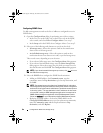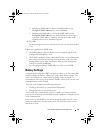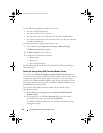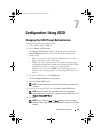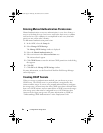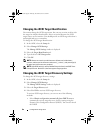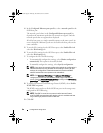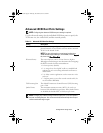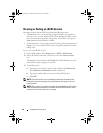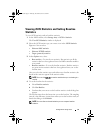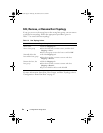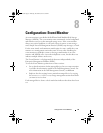
Configuration: Using iSCSI 87
• Select
Specify Configuration
, and type the IPv4 address to activate
the target discovery.
• Type the
iSNS server IP address
in the IPv6 settings area to activate
the target discovery.
After you manually enter an IP address, you can also click
Advanced
to
configure the customized TCP listening ports.
If you do not want to allow discovery sessions that are not named, select
the
Disallow un-named discovery sessions
.
NOTE: Un-named discovery sessions are discovery sessions that are
permitted to run without a target name. With an un-named discovery session,
the target name or the target portal group tag is not available to enforce the
iSCSI session identifier (ISID) rule.
5
Click
OK
.
Configuring the iSCSI Host Ports
The default method for configuring the iSCSI host ports, for IPv4 addressing,
is DHCP. Always use this method unless your network does not have a DHCP
server. It is advisable to assign static DHCP addresses to the iSCSI ports to
ensure continuous connectivity. For IPv6 addressing, the default method is
Stateless auto-configuration. Always use this method for IPv6.
To configure the iSCSI host ports:
1
In the AMW, select the
Setup
tab.
2
Select
Configure iSCSI Host Ports
.
The
Configure iSCSI Host Ports
window is displayed.
3
In the
iSCSI host port
list, select an appropriate RAID controller module
and an iSCSI host port.
The connection status between the storage array and the host appears in
the Status area when you select an iSCSI host port. The connection status
is either connected or disconnected. Additionally, the media access control
address (MAC) of the selected iSCSI host port appears in the MAC
address area.
NOTE: For each iSCSI host port, you can use either IPv4 settings or IPv6
settings or both.
book.book Page 87 Thursday, December 9, 2010 3:20 PM




